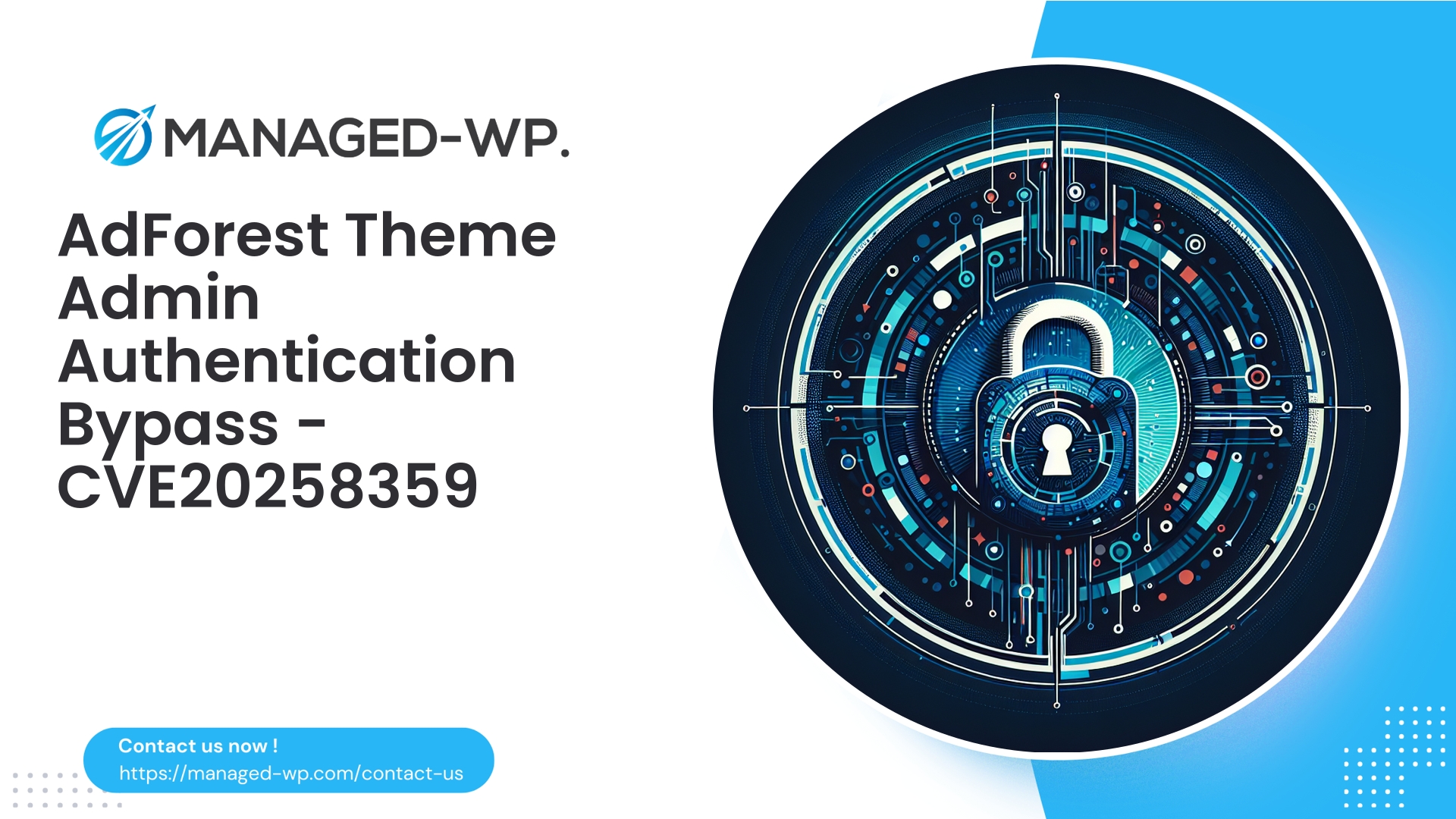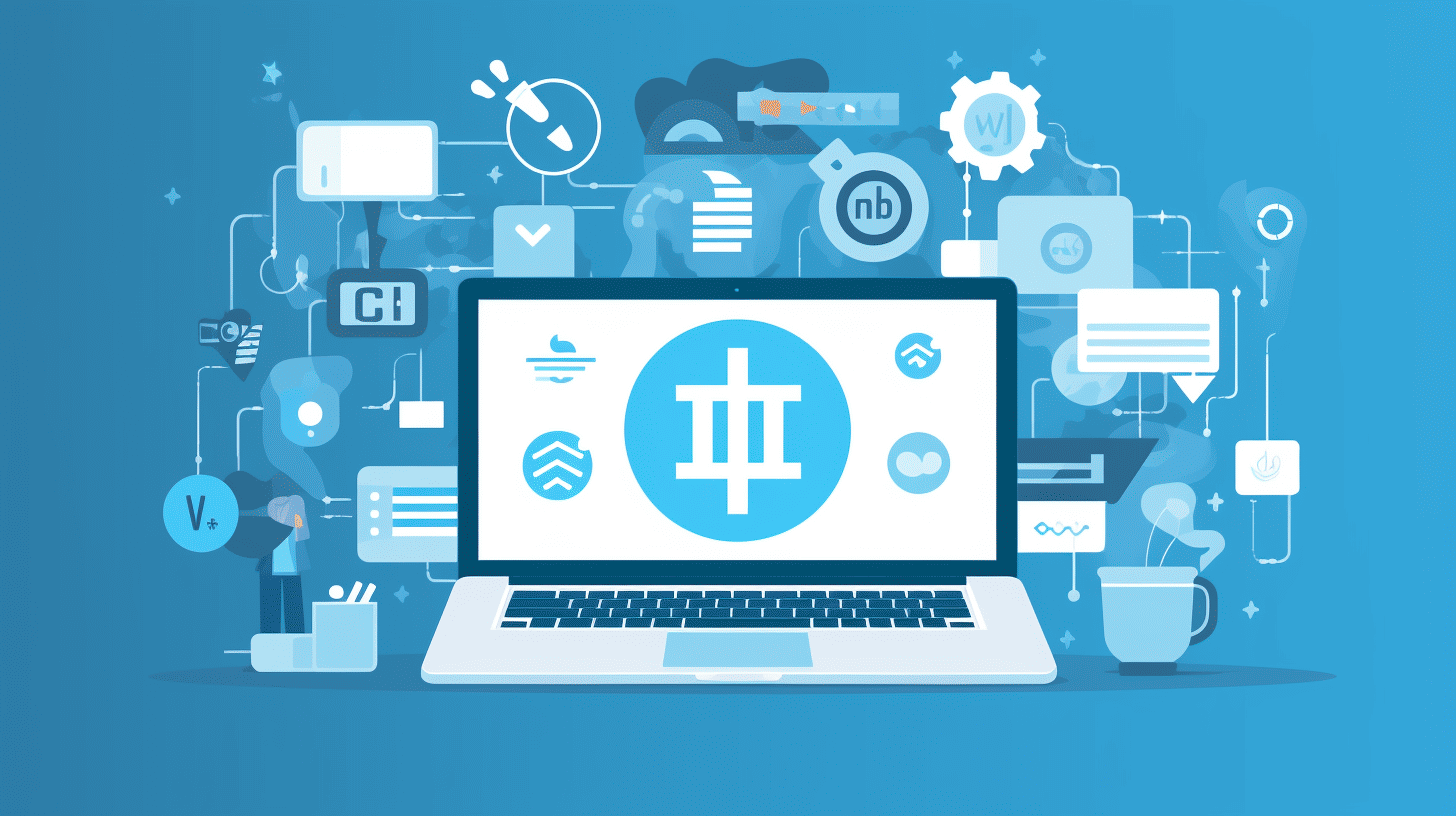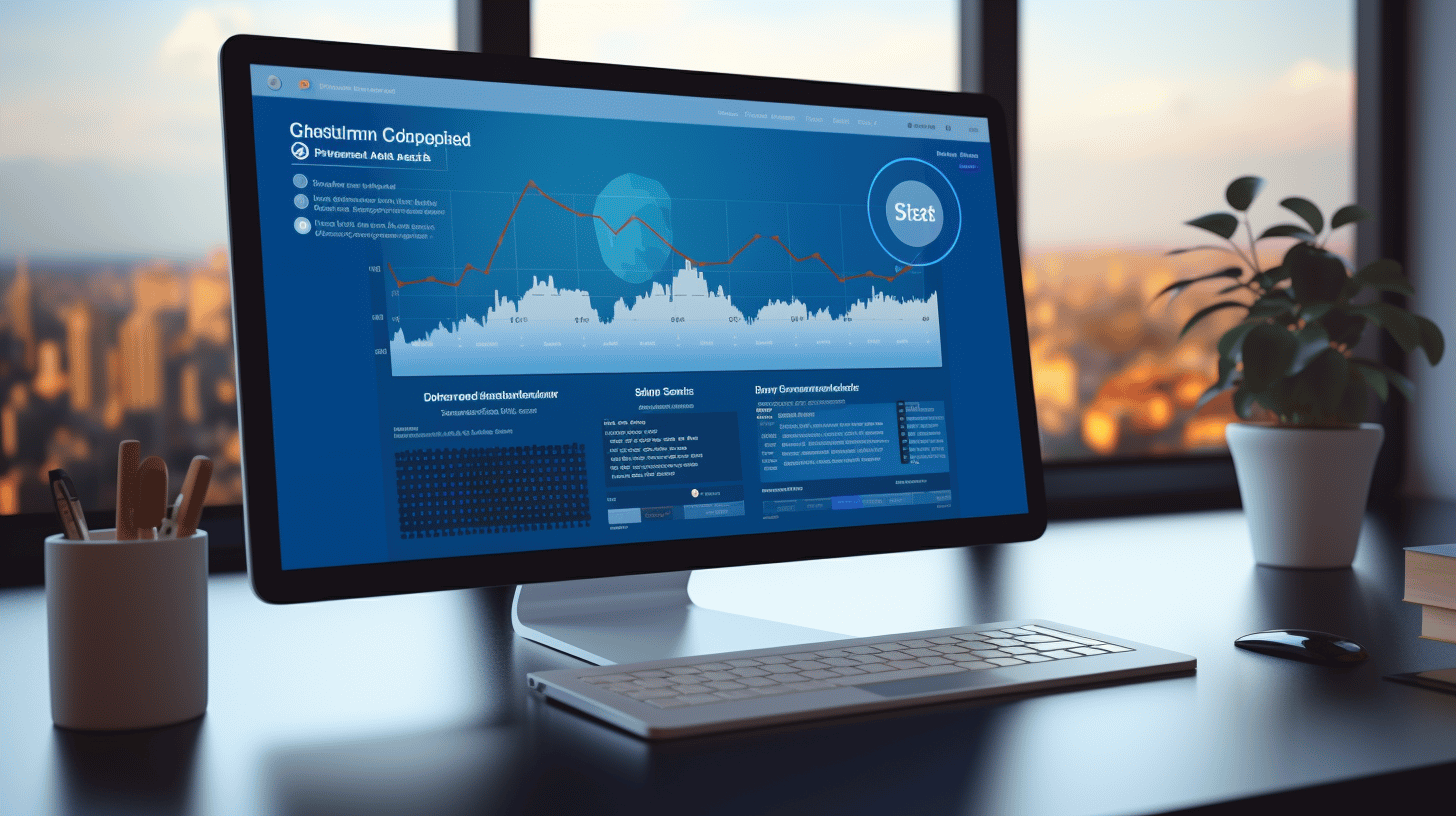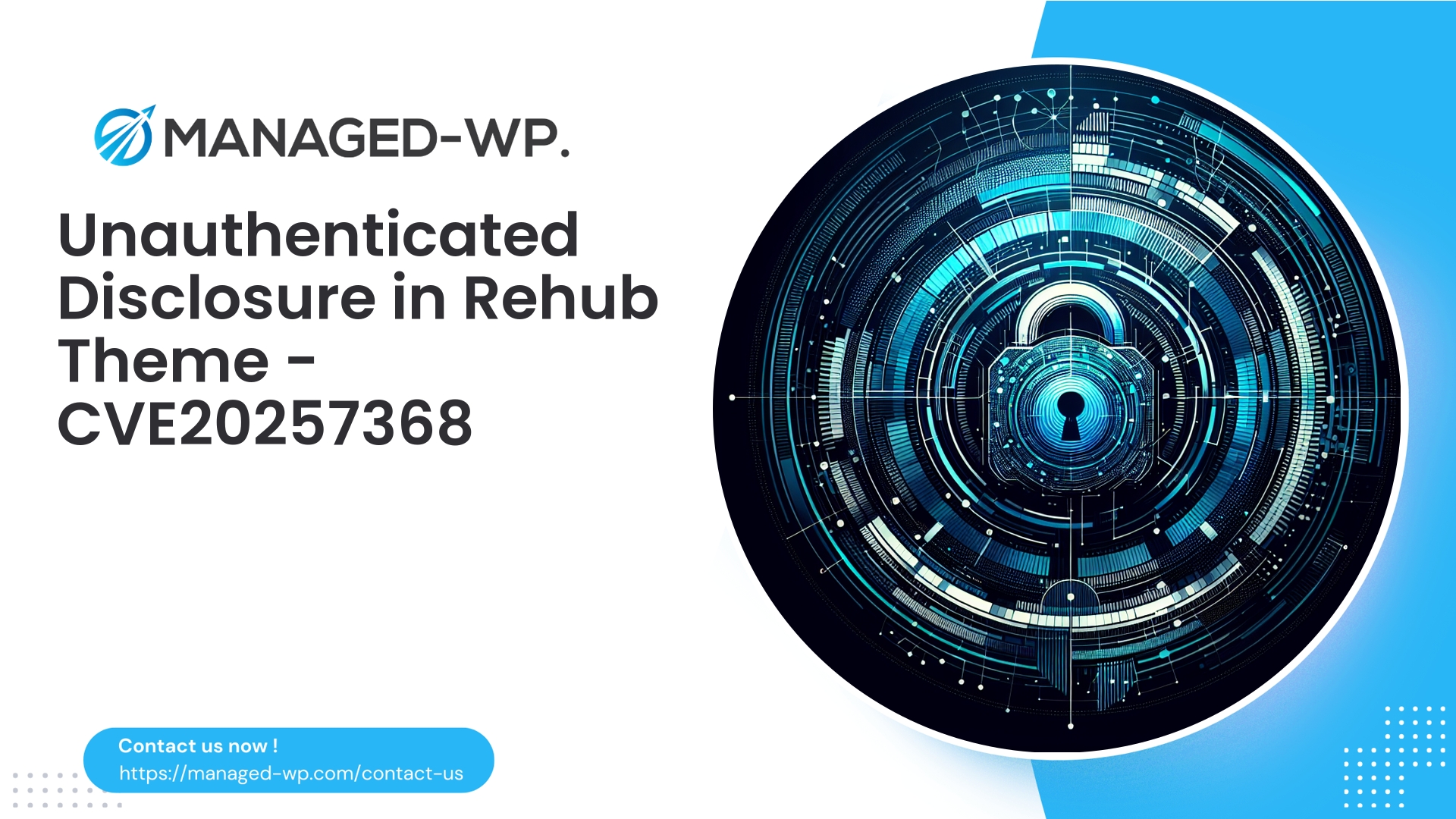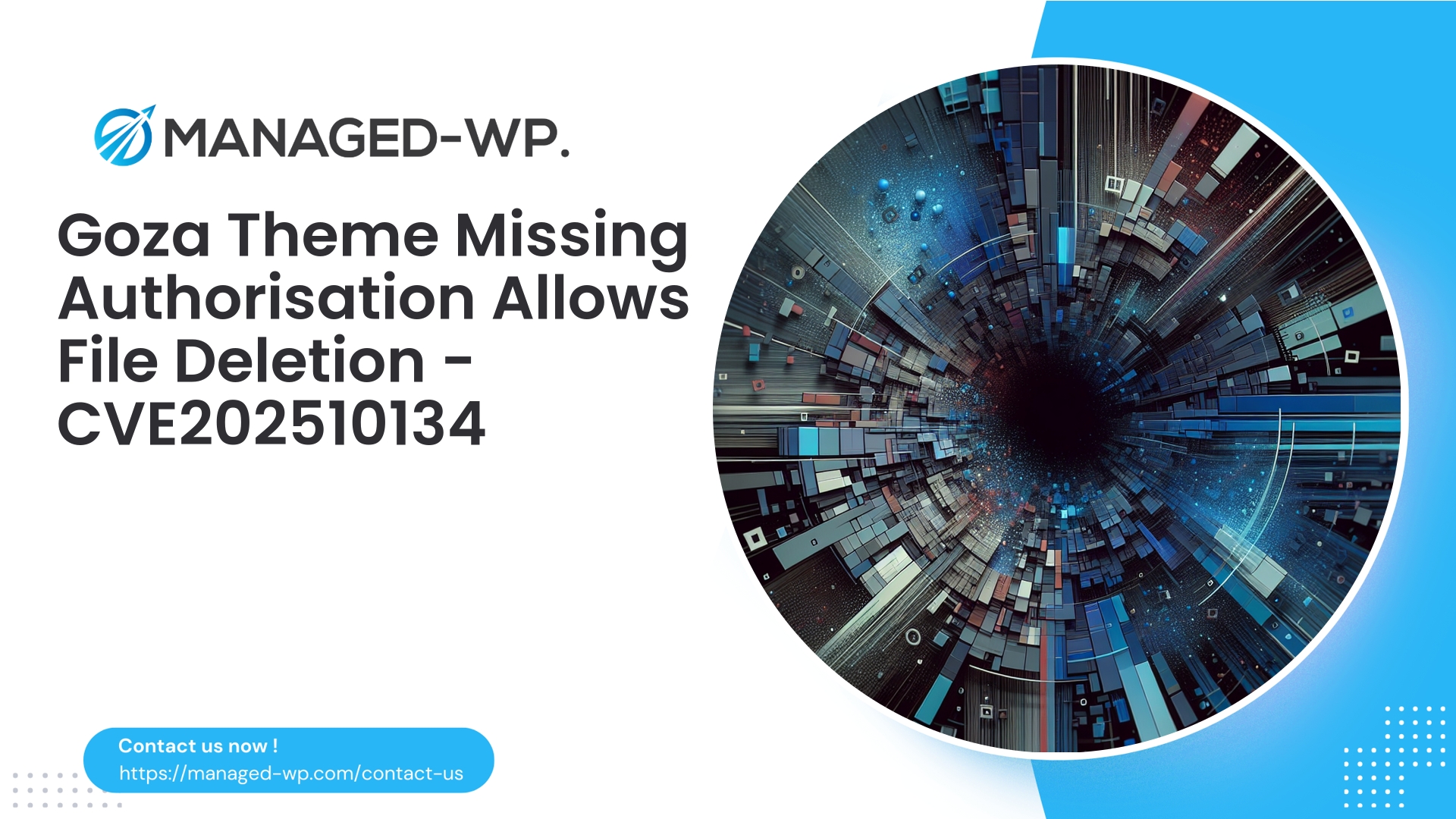| 插件名稱 | AdForest |
|---|---|
| 漏洞類型 | 管理員身份驗證繞過 |
| CVE編號 | CVE-2025-8359 |
| 緊急 | 高的 |
| CVE 發布日期 | 2025-09-06 |
| 來源網址 | CVE-2025-8359 |
嚴重警報:AdForest 主題(<= 6.0.9)驗證繞過漏洞 (CVE-2025-8359) — WordPress 網站所有者應立即採取的措施
來自 Managed-WP 安全專家的權威建議:了解 AdForest 身份驗證繞過 (CVE-2025-8359) 的嚴重性,識別有風險的站點,實施緊急緩解和虛擬修補,執行檢測和事件響應,並加強未來的防禦。
作者: 託管 WordPress 安全團隊
日期: 2025-09-06
類別: 安全性、WordPress、主題、網路應用程式防火牆
標籤: AdForest、驗證繞過、CVE-2025-8359、虛擬修補程式、WAF、事件回應
執行摘要: AdForest 主題版本 6.0.9 及更早版本存在嚴重的身份驗證繞過漏洞 (CVE-2025-8359)。此漏洞允許未經身份驗證的使用者執行特權管理員操作,從而使您的整個網站面臨風險。請立即更新至 AdForest 版本 6.0.10。如果無法立即更新,請套用 Managed-WP 建議的緩解措施和虛擬修補程式來保護您的環境,直到部署正式修補程式為止。
漏洞概述
- 類型: 身份驗證繞過(身份驗證失效)
- 受影響版本: 適用於 WordPress 的 AdForest 主題,版本最高至 6.0.9。
- 補丁可用: AdForest 6.0.10
- CVE標識符: CVE-2025-8359
- 漏洞利用要求: 無-無需有效憑證即可執行攻擊。
- 嚴重程度評分: 嚴重(CVSS 9.8)
此漏洞允許攻擊者繞過標準的 WordPress 驗證控制,從而無需登入即可存取管理功能。常見的安全層,例如登入驗證、權限檢查和 nonce 驗證,均有效繞過。
秉持負責任的資訊揭露和安全最佳實務原則,我們不提供漏洞利用細節。本指南重點在於防禦和應對策略。
為什麼這種漏洞極度危險
- 未經身份驗證的存取: 攻擊者無需任何憑證,即可透過機器人發動大規模自動化攻擊。
- 完全管理員控制權限: 可能允許進行諸如安裝外掛程式/主題、建立管理員使用者以及修改網站內容或設定等變更。
- 快速移動的攻擊視窗: 公開通知發布後,攻擊嘗試立即激增。
- 持續性風險: 攻擊者可以植入後門、定時任務或惡意軟體,以實現長期訪問。
- 進一步開發的機會: 可能與其他漏洞或憑證弱點連鎖。
誰必須採取行動?
- 任何正在使用 AdForest 主題的 WordPress 網站,版本為 6.0.9 或更早版本。
- 透過子主題或自訂修改來維護存在漏洞的 AdForest 主題檔案的網站。
- 使用 AdForest 作為網頁主題的多網站 WordPress 網路。
- 託管服務提供者和代理商管理多個部署了 AdForest 的網站。
即使是未使用的 AdForest 安裝也應該進行審查以評估風險。
場地所有者應立即採取的補救措施
-
升級: 立即將您的 AdForest 主題更新至 6.0.10 或更高版本。
- 請在「外觀」→「主題」中查看您的主題版本,或檢查 style.css 檔案。
- 如果使用子主題,請確保父主題也相應更新。
- 暫時緩解: 如果無法立即進行更新,請部署下方詳細介紹的虛擬修補程式和 Web 應用程式防火牆 (WAF) 規則。
-
加強帳戶安全:
- 強制所有管理者重置密碼。
- 審核所有管理帳戶;刪除或降級任何未識別的使用者。
- 輪換認證鹽和密鑰
wp-config.php. - 盡可能在所有管理員帳戶上實施多因素身份驗證 (MFA)。
-
調查外洩跡象:
- 檢查日誌中是否存在可疑的管理員等級 POST 請求和新使用者建立行為。
- 考察近期變化
wp-content/themes/adforest和wp-content/uploads. - 請遵循以下檢測和取證指南。
- 遏制與清理: 如果發現安全漏洞,請限制公眾造訪以隔離網站,並通知您的主機提供者進行深度掃描。
- 完整掃描: 修補程式和清理完成後,執行惡意軟體掃描和檔案完整性驗證。
短期虛擬補丁和WAF建議
當立即升級主題有困難時,透過 WAF 進行虛擬修補對於減少風險至關重要:
- 封鎖或質疑來自未經認證來源的針對管理員級別操作的請求。
- 強制敏感 POST 端點存在有效的 WordPress nonce。
- 對來自相同 IP 位址的可疑和重複請求進行速率限制。
- 偵測並封鎖包含惡意載荷模式(例如嵌入式 PHP 程式碼或長編碼字串)的請求。
- 透過確認預期的引用頁和主機頁標頭來實現來源驗證。
虛擬補丁規則範例(概念性):
-
拒絕或透過驗證碼挑戰任何缺少有效 WordPress 授權碼的管理員操作請求。
已登入餅乾. - 拒絕向缺少有效 WordPress nonce 的主題修改端點發送 POST 請求。
- 封鎖包含可疑有效載荷模式(例如,base64 編碼的 PHP 程式碼片段)的請求。
- 限制來自單一 IP 的多個未經驗證的管理端點的存取速率。
- 如果適用,對來自意外地區的異常流量激增執行地理位置 IP 封鎖。
- 阻止未經身份驗證的文件上傳和主題編輯器存取嘗試。
筆記: 這些規則最初應以監控模式部署,以評估其影響,避免可能幹擾合法管理員的誤報。
攻擊行為及需要注意的事項
- 自動掃描 AdForest 主題版本和易受攻擊的端點。
- 多次未經授權的嘗試調用行政措施。
- 建立未經授權的管理員使用者、隱藏的後門或修改主題檔案。
- 混淆程式碼注入(例如,base64 編碼)隱藏在主題或上傳目錄中。
由於攻擊者無需登入即可執行管理員級別的操作,因此您的監控必須專注於來自未經身份驗證的來源的異常「類似管理員」的請求。
偵測策略:日誌、檔案系統稽核和資料庫查詢
A. Web伺服器日誌
- 過濾未經驗證的 IP 位址對管理 URL 的 POST/GET 請求。
- 識別針對管理端點的自動化用戶代理字串或快速請求突發。
B. WordPress 日誌
- 追蹤 REST API 呼叫和
admin-ajax.phpPOST 操作會修改使用者、選項或主題檔案。
C. 資料庫調查
- 最近新增了管理員帳號:
SELECT user_login, user_email, user_registered FROM wp_users WHERE user_registered > 'YYYY-MM-DD';
- 權限提升:
SELECT * FROM wp_usermeta WHERE meta_key = 'wp_capabilities' AND meta_value LIKE '%administrator%';
D. 檔案系統檢查
- 尋找最近修改過的文件(最近 7 天內):
尋找 /path/to/wp-content -type f -mtime -7 -ls
- 掃描
wp-content/themes/adforest和wp-content/uploads用於不尋常或新的 PHP 檔案。 - 檢測可疑功能,例如
評估,base64解碼以及系統調用。 - 檢查已排程的 WordPress Cron 作業是否有未知或註入的任務。
E. 妥協指標 (IOC)
- 未識別的管理員帳戶、可疑的新外掛程式、修改過的主題檔案、上傳檔案中的未知 PHP 檔案以及不尋常的排程事件。
F. 保存法醫證據
- 清理之前,安全地收集並儲存相關日誌、WP 配置快照和檔案元資料。
事件回應和復原檢查清單
- 妥善保管並存檔所有法醫證據。
- 將網站置於維護模式或限制使用者存取。
- 強制重置所有管理員密碼並撤銷所有活動會話。
- 更改所有可能被洩露的 API 和整合金鑰。
- 在測試環境中升級 AdForest 主題並進行驗證,然後再正式上線。
- 刪除所有未經授權的管理員使用者以及可疑的外掛程式或檔案。
- 如果安全漏洞嚴重,請從已驗證的備份中復原。
- 修復後加強防禦:實施雙重認證、強制使用強密碼、按 IP 位址限制管理員存取權限,並部署安全性外掛程式或託管 WAF。
- 進行惡意軟體掃描和手動文件審查,以驗證清理效果。
- 如果敏感資料可能洩露,應按照相關法律要求通知利害關係人。
推薦的長期安全措施
- 請確保 WordPress 核心程式、主題和外掛程式已安裝最新的安全性修補程式。
- 透過新增以下內容來停用 WordPress 中的文件編輯功能
定義('DISALLOW_FILE_EDIT',true);致你wp-config.php. - 對使用者角色應用最小權限原則。
- 對管理者使用者強制執行強密碼、唯一密碼和多因素身份驗證 (MFA)。
- 利用具有虛擬修補程式功能的託管式 WAF 來緩解零日漏洞。
- 使用安全的託管環境,配備最新版本的 PHP、正確的檔案權限,並僅允許 SFTP 存取。
- 定期使用異地儲存備份您的網站,並測試復原流程。
- 透過校驗和驗證外掛程式或工具監控檔案完整性。
- 盡可能透過 IP 位址限制 wp-admin 存取權限,或使用白名單。
- 定期輪換安全鹽和鑰匙
wp-config.php.
受管WP用戶的範例虛擬補丁規則
-
阻止未經身份驗證且無有效憑證的 POST 請求存取管理端點。
已登入cookie 或 WordPress nonce 缺失。盡可能使用驗證碼挑戰。 - 對 REST API 寫入路由強制執行 referer 和 host 標頭驗證。
-
阻止包含可疑程式碼模式的參數(例如,
base64解碼,eval()). - 對來自相同 IP 位址的存取管理端點的枚舉嘗試進行速率限制。
- 暫時將觸發多個可疑請求的 IP 位址列入黑名單。
請務必先在監控模式下執行新的防火牆規則,並在全面強制執行之前檢查日誌是否有誤報。
日誌記錄、警報和監控
- 啟用所有虛擬補丁規則的詳細日誌記錄。
- 建立警報,提醒使用者註意諸如建立新管理員和向管理員 URL 發送大量未經授權的 POST 請求等事件。
- 保留日誌 30-90 天,以便於調查。
- 在企業環境中採用強制啟用多因素身份驗證 (MFA) 的單一登入 (SSO)。
面向託管服務提供者和代理商的規模化回應
對於管理多個 WordPress 網站的組織:
- 使用 AdForest 繪製網站地圖並驗證主題版本。
- 盡可能實現主題更新自動化,並事先進行嚴格測試。
- 在 WAF 或邊緣防火牆上部署全網虛擬修補程式。
- 向客戶提供清晰的指示和補救協助。
- 優先考慮關鍵和高曝光環境,例如面向公眾或交易的網站。
常見問題解答
Q:升級到 AdForest 6.0.10 後,我的網站安全嗎?
答:更新可以消除漏洞,但您仍然應該進行徹底的審計,以檢測先前的入侵情況並清除可能存在的後門。
問:我能完全依賴妻子的同意嗎?
答:網路應用防火牆(WAF)是提供即時保護的重要臨時措施,但它不能取代修補程式。在部署官方更新和掃描程式期間,可以使用虛擬修補程式來爭取時間。
Q:更新會破壞主題自訂設定嗎?
答:子主題中的自訂設定通常會保留。如果您直接修改了父主題文件,請在測試環境中測試更新,並考慮將自訂設定移轉到子主題。
Q:修復後我該監測多久?
答:至少要監控 30 天,因為攻擊者可能已經設定了持久性存取點。
事件時間軸範例
- 第0天: 公開揭露漏洞會觸發自動掃描和攻擊嘗試。
- 第0-2天: 針對類似管理員端點的未經身份驗證的 POST 請求數量明顯增加。
- 第2-7天: 出現濫用跡象,例如新管理員帳戶或可疑上傳內容。
- 第 7 天及以後: 可能存在低頻後門活動;繼續進行長期監控和完整性驗證。
事件回應檢查表
- 請驗證 AdForest 版本(外觀 → 主題或 style.css)
- 如果版本≤6.0.9,請立即規劃更新至6.0.10
- 部署 WAF 虛擬修補程式規則以阻止未經身份驗證的管理員操作
- 輪換所有管理員密碼並撤銷會話
- 對管理員帳戶強制執行多因素身份驗證 (MFA)
- 執行惡意軟體掃描並驗證檔案完整性
- 搜尋新的管理員用戶和可疑的插件或文件
- 保留所有日誌和證據以備法醫分析。
- 如果無法進行全面修復,則從乾淨的備份中復原。
- 詳細記錄所有補救步驟和時間表。
Managed-WP 安全工程師的最終顧問意見
驗證繞過漏洞會破壞基本的存取控制,對 WordPress 網站構成嚴重威脅。公開揭露和自動化掃描相結合,會顯著增加被利用的風險。
我們強烈建議立即進行修補程式修復,並隨後採取嚴格的事件回應措施,在無法立即套用修補程式的情況下,進行虛擬修補程式部署。即使打完修補程式後,也應執行詳細的完整性和入侵檢查——擁有先前管理員權限的攻擊者可能已經建立了隱藏的持久化機制。
強大的安全防護需要多層防禦:最新的軟體、嚴格的存取控制、持續監控、備份以及協同工作的託管式 Web 應用防火牆 (WAF) 解決方案。對於管理多個網站的組織而言,優先應用程式修補程式和虛擬修補程式是速度最快、最有效的保護方法。
立即開始保護您的 WordPress 網站—試試 Managed-WP 的免費保護計劃
使用 Managed-WP 的基本(免費)託管防火牆服務,立即保護您的 WordPress 部署——該服務旨在阻止 AdForest 身份驗證繞過等攻擊嘗試,同時您可以進行修補或回應。
- 免費版功能:
- 針對已知漏洞客製化的託管防火牆和WAF規則
- 安全相關流量不收取頻寬費用
- 自動惡意軟體掃描和警報
- 涵蓋OWASP十大關鍵風險
在此註冊 Managed-WP Basic(免費): https://my.wp-firewall.com/buy/wp-firewall-free-plan/
為了獲得更強大的保護,請考慮 Managed-WP 的標準版和專業版套餐,這些套餐提供自動惡意軟體清除、黑名單/白名單管理、虛擬修補程式、月度報告和專屬專家支援等功能。
我們的服務旨在支持您的安全態勢
- 根據您的 WordPress 環境自訂開發 WAF 規則。
- 為受損網站提供全面的事件分類和清理服務。
- 在修補程式部署期間,實現全艦隊虛擬修補程式集成,以保護多個網站。
為了獲得量身定制的安全評估,請提供您的網站 URL、託管詳情、測試環境狀態和備份可用性。 Managed-WP 將提供一份優先排序的修復路線圖和一套可立即部署的規則集,旨在實現快速防禦。











